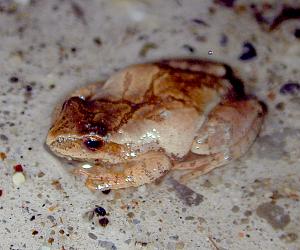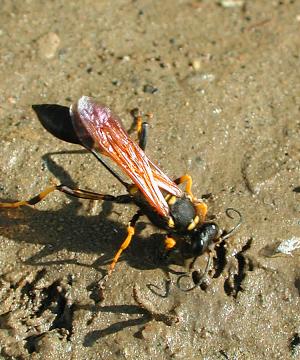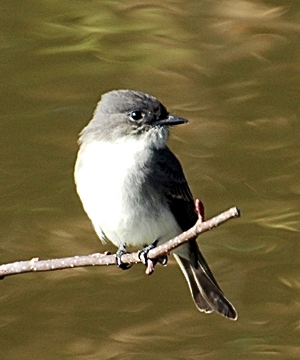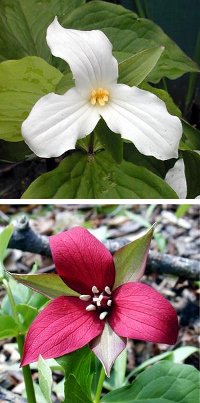Now and Then: E. T. Seton
 Ernest Thompson Seton (1860 - 1946) was a Scots-Canadian who became a noted author, wildlife artist, founder of the Woodcraft Indians, and one of the founding pioneers of the Boy Scouts of America. [from Wikipedia] Seton's book “Two Little Savages,” probably set around the 1870s, describes his adventures while growing up in Toronto. The following is an annotated version of one of this book's chapters.
Ernest Thompson Seton (1860 - 1946) was a Scots-Canadian who became a noted author, wildlife artist, founder of the Woodcraft Indians, and one of the founding pioneers of the Boy Scouts of America. [from Wikipedia] Seton's book “Two Little Savages,” probably set around the 1870s, describes his adventures while growing up in Toronto. The following is an annotated version of one of this book's chapters.
The Collarless Stranger
Oh, sympathy! the noblest gift of God to man. The greatest bond
there is twixt man and man.
The strongest link in any friendship chain.
The single lasting hold in kinship's claim.
The only incorrosive strand in marriage bonds.
The blazing torch where genius lights her lamp.
The ten times noble base of noblest love.
More deep than love—more strong than hate—the biggest thing
in all the universe—the law of laws.
Grant but this greatest gift of God to man—this single link
concatenating grant, and all the rest are worthless or comprised.
Each year the ancient springtime madness came more strongly on Yan. Each year he was less inclined to resist it, and one glorious day of late April in its twelfth return he had wandered northward along to a little wood a couple of miles from the town. It was full of unnamed flowers and voices and mysteries. Every tree and thicket had a voice—a long ditch full of water had many that called to him. “Peep-peep-peep,” they seemed to say in invitation for him to come and see. He crawled again and again to the ditch and watched and waited. The loud whistle would sound only a few rods away, “Peep-peep-peep,” but ceased at each spot when he came near—sometimes before him, sometimes behind, but never where he was. He searched through a small pool with his hands, sifted out sticks and leaves, but found nothing else. A farmer going by told him it was only a “spring Peeper,” whatever that was, “some kind of a critter in the water.”
Under a log not far away Yan found a little Lizard that tumbled out of sight into a hole. It was the only living thing there, so he decided that the “Peeper” must be a “Whistling Lizard.” But he was determined to see them when they were calling. How was it that the ponds all around should be full of them calling to him and playing hide and seek and yet defying his most careful search? The voices ceased as soon as he came near, to be gradually renewed in the pools he had left. His presence was a husher. He lay for a long time watching a pool, but none of the voices began again in range of his eye. At length, after realizing that they were avoiding him, he crawled to a very noisy pond without showing himself, and nearer and yet nearer until he was within three feet of a loud peeper in the floating grass. He located the spot within a few inches and yet could see nothing. He was utterly baffled, and lay there puzzling over it, when suddenly all the near Peepers stopped, and Yan was startled by a footfall; and looking around, he saw a man within a few feet, watching him.
Yan reddened—a stranger was always an enemy; he had a natural aversion to all such, and stared awkwardly as though caught in crime.
The man, a curious looking middle-aged person, was in shabby clothes and wore no collar. He had a tin box strapped on his bent shoulders, and in his hands was a long-handled net. His features, smothered in a grizzly beard, were very prominent and rugged. They gave evidence of intellectual force, with some severity, but his gray-blue eyes had a kindly look.
He had on a common, unbecoming, hard felt hat, and when he raised it to admit the pleasant breeze Yan saw that the wearer had hair like his own—a coarse, paleolithic mane, piled on his rugged brow, like a mass of seaweed lodged on some storm-beaten rock.
“F'what are ye fynding, my lad?” said he in tones whose gentleness was in no way obscured by a strong Scottish tang.
Still resenting somewhat the stranger's presence, Yan said:
“I'm not finding anything; I am only trying to see what that Whistling Lizard is like.”
The stranger's eyes twinkled. “Forty years ago Ah was laying by a pool just as Ah seen ye this morning, looking and trying hard to read the riddle of the spring Peeper. Ah lay there all day, aye, and mony anither day, yes, it was nigh onto three years before Ah found it oot. Ah'll be glad to save ye seeking as long as Ah did, if that's yer mind. Ah'll show ye the Peeper.”
Then he raked carefully among the leaves near the ditch, and soon captured a tiny Frog, less than an inch long.
“Ther's your Whistling Lizard: he no a Lizard at all, but a Froggie. Book men
call him Hyla pickeringii,
 Now Pseudacris crucifer. Unfortunately this species is now very rare in Toronto.
There are a few recent records at Eglinton Flats,
the Rouge Park, and Etobicoke Creek.
an' a gude Scotchman he'd make, for ye see the St.
Andrew's cross on his wee back. Ye see the whistling ones in the water put on'y
their beaks oot an' is hard to see. Then they sinks to the bottom when ye come
near. But you tak this'n home and treat him well and ye'll see him blow out his
throat as big as himsel' an' whistle like a steam engine.”
Now Pseudacris crucifer. Unfortunately this species is now very rare in Toronto.
There are a few recent records at Eglinton Flats,
the Rouge Park, and Etobicoke Creek.
an' a gude Scotchman he'd make, for ye see the St.
Andrew's cross on his wee back. Ye see the whistling ones in the water put on'y
their beaks oot an' is hard to see. Then they sinks to the bottom when ye come
near. But you tak this'n home and treat him well and ye'll see him blow out his
throat as big as himsel' an' whistle like a steam engine.”
Yan thawed out now. He told about the Lizard he had seen.
“That wasna a Lizard; Ah niver see thim aboot here. It must a been a two-striped Spelerpes. Northern Two-lined Salamander (Eurycea bislineata). It does not exist in Toronto, and it's not listed in the 1913 book "The Natural History of the Toronto Region". Perhaps he is referring to the Eastern Redback Salamander (Plethodon cinereus)? A Spelerpes is nigh kin to a Frog—a kind of dry-land tadpole, while a Lizard is only a Snake with legs.”
This was light from heaven. All Yan's distrust was gone. He warmed to the
stranger. He plied him with questions; he told of his getting the Bird Book.
Oh, how the stranger did snort at “that driveling trash.” Yan talked of his
perplexities. He got a full hearing and intelligent answers. His mystery of the
black ground-bird with a brown mate was resolved into the Common Towhee.
Eastern Towhee (Pipilo erythrophthalmus).
The unknown wonderful voice in the spring morning, sending out its “cluck, cluck,
cluck, clucker,” in the distant woods, the large gray Woodpecker that bored in
some high stub and flew in a blaze of gold, and the wonderful spotted bird with
red head and yellow wings and tail in the taxidermist's window, were all
resolved into one and the same—the Flicker or Golden-winged Woodpecker.
Northern Flicker (Colaptes auratus).
The
Hang-nest and the Oriole
Northern Oriole (Icterus galbula).
became one. The unknown poisonous-looking blue Hornet,
that sat on the mud with palpitating body, and the strange, invisible thing
that made the mud-nests inside old outbuildings and crammed them with crippled
Spiders, were both identified as the Mud-wasp or Pelopæus.
 Sceliphron
Sceliphron
A black Butterfly flew over, and Yan learned that it was a Camberwell Beauty,
 More commonly known as Mourning Cloak in North America; currently
classified as Nymphalis antiopa.
It is fairly common, and one of our earliest butterflies.
or, scientifically, a Vanessa antiopa, and that this one must have hibernated
to be seen so early in the spring, and yet more, that this beautiful creature
was the glorified spirit of the common brown and black spiney Caterpillar.
More commonly known as Mourning Cloak in North America; currently
classified as Nymphalis antiopa.
It is fairly common, and one of our earliest butterflies.
or, scientifically, a Vanessa antiopa, and that this one must have hibernated
to be seen so early in the spring, and yet more, that this beautiful creature
was the glorified spirit of the common brown and black spiney Caterpillar.
The Wild Pigeons Passenger Pigeon (Ectopistes migratorius). This once incredibly numerous species (it was said to darken the skies during migration) is now extinct. The last known specimen, called Martha, died in 1914. were flying high above them in great flocks as they sat there, and Yan learned of their great nesting places in the far South, and of their wonderful but exact migrations without regard to anything but food; their northward migration to gather the winged nuts of the Slippery Elm in Canada; their August flight to the rice-fields of Carolina; their Mississippi Valley pilgrimage when the acorns and beech-mast were falling ripe.
What a rich, full morning that was. Everything seemed to turn up for them. As they walked over a piney hill, two large birds sprang from the ground and whirred through the trees.
“Ruffed Grouse or 'patridge', Ruffed Grouse, Bonasa umbellus. In another book, "Wild Animals I Have Known", Seton wrote "Redruff, the Story of the Don Valley Partridge". It does not occur in Toronto any more. as the farmers call them. There's a pair lives nigh aboots here. They come on this bank for the Wintergreen Gaultheria procumbens, also known as Checkerberry or Partridgeberry. berries.”
And Yan was quick to pull and taste them. He filled his pockets with the aromatic plant—berries and all—and chewed it as he went. While they walked, a faint, far drum-thump fell on their ears. “What's that?” he exclaimed, ever on the alert. The stranger listened and said:
“That's the bird ye ha' just seen; that's the Cock Partridge drumming for his mate.”
The Pewee of his early memories became the Phoebe
 Eastern Phoebe (Sayornis phoebe)
of books.
That day his brookside singer became the Song-sparrow; the brown triller, the Veery Thrush.
The Trilliums,
white and red,
Eastern Phoebe (Sayornis phoebe)
of books.
That day his brookside singer became the Song-sparrow; the brown triller, the Veery Thrush.
The Trilliums,
white and red,
 These two species (Trillium erectum and T. grandiflorum) are common in many Toronto ravines.
the Dogtooth Violet,
These two species (Trillium erectum and T. grandiflorum) are common in many Toronto ravines.
the Dogtooth Violet,
 Also called Trout Lily (Erythronium americanum); fairly common in our ravines.
the Spring-beauty,
Also called Trout Lily (Erythronium americanum); fairly common in our ravines.
the Spring-beauty,
 There are two species of Spring beauty in Toronto: Spring Beauty (Claytonia caroliniana) and Narrow-leaved Spring Beauty (Claytonia virginica). Based on Seton's drawing that accompanies the text, he is likely referring to Narrow-leaved Spring Beauty.
the Trailing Arbutus
A boreal species, rare in Toronto; two places where it has been recorded are High Park (along Spring Road Ravine) and Glen Stewart Ravine.
—all for the first time got names and became real friends,
instead of elusive and beautiful, but depressing mysteries.
There are two species of Spring beauty in Toronto: Spring Beauty (Claytonia caroliniana) and Narrow-leaved Spring Beauty (Claytonia virginica). Based on Seton's drawing that accompanies the text, he is likely referring to Narrow-leaved Spring Beauty.
the Trailing Arbutus
A boreal species, rare in Toronto; two places where it has been recorded are High Park (along Spring Road Ravine) and Glen Stewart Ravine.
—all for the first time got names and became real friends,
instead of elusive and beautiful, but depressing mysteries.
The stranger warmed, too, and his rugged features glowed; he saw in Yan one minded like himself, tormented with the knowledge-hunger, as in youth he himself had been; and now it was a priceless privilege to save the boy some of what he had suffered. His gratitude to Yan grew fervid, and Yan—he took in every word; nothing that he heard was forgotten. He was in a dream, for he had found at last the greatest thing on earth—sympathy—broad, intelligent, comprehensive sympathy.
That spring morning was ever after like a new epoch in Yan's mind—not his memory, that was a thing of the past—but in his mind, his living present.
And the strongest, realest thing in it all was, not the rugged stranger with his kind ways, not the new birds and plants, but the smell of the Wintergreen.
Smell's appeal to the memory is far better, stronger, more real than that of any other sense. The Indians know this; many of them, in time, find out the smell that conjures up their happiest hours, and keep it by them in the medicine bag. It is very real and dear to them—that handful of Pine needles, that lump of Rat-musk, or that piece of Spruce gum. It adds the crown of happy memory to their reveries.
And yet this belief is one of the first attacked by silly White-men, who profess to enlighten the Red-man's darkness. They, in their ignorance, denounce it as absurd, while men of science know its simple truth.
Yan did not know that he had stumbled on a secret of the Indian medicine bag. But ever afterward that wonderful day was called back to him, conjured up by his “medicine,” this simple, natural magic, the smell of the Wintergreen.
He appreciated that morning more than he could tell, and yet he did a characteristic foolish thing, that put him in a wrong light and left him so in the stranger's mind.
It was past noon. They had long lingered; the Stranger spoke of the many things he had at home; then at length said he must be going. “Weel, good-by, laddie; Ah hope Ah'll see you again.” He held out his hand. Yan shook it warmly; but he was dazed with thinking and with reaction; his diffidence and timidity were strong; he never rose to the stranger's veiled offer. He let him go without even learning his name or address.
When it was too late, Yan awoke to his blunder. He haunted all those woods in hopes of chancing on him there again, but he never did.